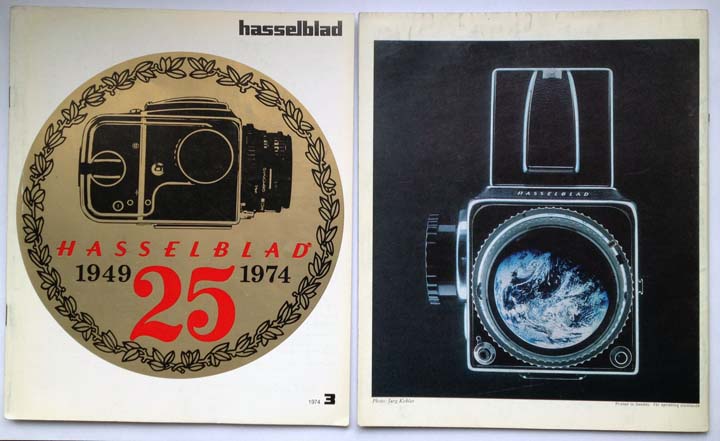Hasselblad of Gothenburg
As a lead-up to the 2013 Hasselblad Prize, to be announced on March 7, and claimed last year by Paul Graham, I’ll be posting a series of features on Hasselblad Magazine. Yesterday I stumbled on a handful of issues from the 1970s, which understandably feature the camera’s importance in the NASA space program. But first, a little background, verbatim from the 25th anniversary issue in 1974—and you won’t find this story in detail on the Hasselblad Foundation website!
The German attack on Denmark and Norway, “Weserübung,” in April 1940 during the Second World War was immediately followed by complete mobilization of the Swedish armed forces. A German aerial camera was found in the wreckage of a German reconnaissance plane shot down while violating neutral Sweden’s air space. The Royal Swedish Air Force needed cameras, and thirty-four year old Victor Hasselblad, already a famous name in photography, was asked: “Can you make a camera like this?” His answer was: “Well, not exactly. I can do better.”
The prototype of the first hand-held Hasselblad aerial camera was quickly assembled according to Viktor Hsselblad’s ideas and instructions. By the beginning of 1941, twenty hand-picked men had been hired by Ross Aktiebolag which soon changed its name to Victor Hasselblad Aktiebolag. Serial production of the HK7 started in a small factory in Göteborg [Gothenburg]. The work force had increased to 30 people by the following year. Specifications for the HK7 aerial camera were frozen in Stockholm on July 17, 1942, and the cameras were in use….
The period from 1940 to 1949 and up to the Hasselblad system of [1974] was characterized by development and an improvisation which careful scrutiny will show to have been a process of scrupulous planning.

The Air Force started looking for a new, large-format camera for fixed mounting in reconnaissance planes. The factory was also given this assignment. The result was the development of the 4¾” square (12 x 12 cm) Ska4. It retained interchangeability of film magazines and lenses, but the camera used an optical viewfinder with a built-in magnifier through which the photographer was able to obtain a clear view of the terrain to be covered. This viewfinder was mounted through the base of the fuselage. The Ska4 was motor-driven and featured an in intervalometer in addition to red, green and yellow filters and filter mounts. The time was recorded in a corner of the film. Forty-eight such cameras were delivered in a short space of time.
From 1941-1948, the period we have chosen to call “historic,” the factory also manufactured the Dokumat camera with an accessory light table for document copying….A batch of X-ray cameras with advanced optics, an ingeniously designed pan head for the Swedish Army’s ground reconnaissance camera tripod and a ball-and-socket head for civilian tripods were other items produced.
A projector for 35 mm slides was the last product made in the period under review. It was a relatively compact unit featuring heat-absorbing glass and an excellent lens (a 127 mm f/3.5 coated Anastigmat) from Eastman Kodak, Rochester. The Ross projector, as it was called, had a lovely green wrinkle enamel finish. More than 5,000 Ross projectors were made by Hasselblad. Production was later resumed by another company for a few years.
The end of the “historic” period was marked by the prototype Hasselblad 1600F and its introduction in New York in October 1948, an event which was the sensation of the year in the trade press. After many hectic years of effort by himself and his co-workers since 1940, Victor Hasselblad was personally able to present the world’s first 2¼” x 2¼” single lens reflex camera with interchangeable opics and film magazines. Serial production began in April 1949, but that, as Rudyard Kipling put it, “is another story.”


